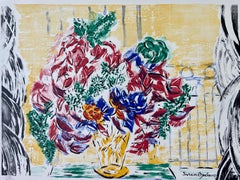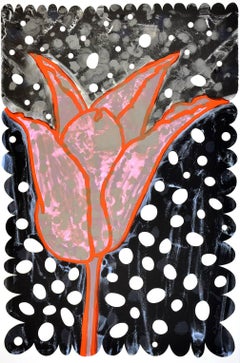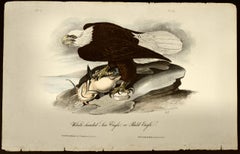(after) Marcel Duchamp Landscape Prints
to
1
1
Overall Width
to
Overall Height
to
1
169
158
146
131
1
1
1
1
1
1
1
1
1
1
Artist: (after) Marcel Duchamp
Anemones by Suzanne Duchamp
By (after) Marcel Duchamp
Located in Belgrade, MT
Color lithograph, hand signed and numbered.
Dada Paris
Printed Guilde de la Gravure stamp
Category
Mid-20th Century Dada (after) Marcel Duchamp Landscape Prints
Materials
Lithograph
$1,196 Sale Price
20% Off
Related Items
Flores para la Ñusta II
By Ana Maria Hernando
Located in Lyons, CO
Color lithograph with cut outs, Edition 30.
Flores para la Ñusta translates as "Flowers for the Ñusta". The artist states:
"In the Andean cosmology, the Ñusta is the feminine ...
Category
21st Century and Contemporary Contemporary (after) Marcel Duchamp Landscape Prints
Materials
Lithograph
"Bald Eagle", an Original Audubon Hand-colored First Edition Lithograph
By After John James Audubon
Located in Alamo, CA
An original rare and extremely collectible first octavo edition John James Audubon hand-colored royal octavo lithograph entitled "White-headed Sea Eagle or Bald Eagle", No. 3, Plate ...
Category
Mid-19th Century Naturalistic (after) Marcel Duchamp Landscape Prints
Materials
Lithograph
Strada St. Giovanni, Valetta - Original Lithograph - Early-19th Century
Located in Roma, IT
Strada St. Giovanni, Valetta is an original modern artwork realized in Italy in the first half of the 19th Century.
Original Lithograph on Ivory Paper.
Inscripted in capital lette...
Category
1850s Modern (after) Marcel Duchamp Landscape Prints
Materials
Lithograph
$239
H 7.49 in W 5.12 in D 0.04 in
Bataille de Fleurs (Carnaval of Flowers) from Nice and the Côte d’Azur
By Marc Chagall
Located in Missouri, MO
After Marc Chagall (1887 - 1985)
By Charles Sorlier (French, 1921-1990)
"Bataille de Fleurs (Carnaval of Flowers)" (from Nice and the Côte d’Azur), 1967
Reference: CS 33
Color Lithograph
Image Size: 24 7/16 in x 18 in (62 cm x 45.8 cm)
Sheet Size: 29 9/16 in x 20 11/16 in (75 x 52.5 cm)
Framed Size: approx. 34 x 27 inches
Edition: Numbered 1 of 150 in pencil in the lower left margin and printed on Arches wove paper (aside from an edition of 75 signed and numbered in Roman numerals and 10 artist's proofs).
Signature: This work is hand signed by Marc Chagall (Vitebsk, 1887 - Saint-Paul, 1985) in pencil in the lower right margin.
Marc Chagall was a man of keen intelligence, a shrewd observer of the contemporary scene, with a great sympathy for human suffering. He was born on July 7, 1887 in Vitebsk, Russia; his original name was Moishe Shagal (Segal), but when he became a foremost member of the Ecole de Paris, he adopted French citizenship and the French spelling of his name. Vitebsk was a good-sized Russian town of over 60,000, not a shtetl. His father supported a wife and eight children as a worker in a herring-pickling plant.
Sheltered by the Jewish commandment against graven images, the young Chagall never saw so much as a drawing until, one day, he watched a schoolmate copying a magazine illustration. He was ridiculed for his astonishment, but he began copying and improvising from magazines. Both Chagall's parents reluctantly agreed to let him study with Yehuda Pen, a Jewish artist in Vitebsk. Later, in 1906, they allowed their son to study in St. Petersburg, where he was exposed to Russian Iconography and folk art. At that time, Jews could leave the Pale only for business and employment and were required to carry a permit. Chagall, who was in St. Petersburg without a permit, was imprisoned briefly.
His first wife, Bella Rosenfeld, was a product of a rich cultivated and intellectual group of Jews in Vitebsk. Chagall was made commissar for the arts for the area, charged with directing its cultural life and establishing an art school. Russian folklore, peasant life and landscapes persisted in his work all his life. In 1910 a rich patron, a lawyer named Vinaver, staked him to a crucial trip to Paris, where young artists were revolutionizing art. He also sent him a handsome allowance of 125 francs (in those days about $24) each month. Chagall rejected cubism, fauvism and futurism, but remained in Paris. He found a studio near Montparnasse in a famous twelve-sided wooden structure divided into wedge-shaped rooms. Chaim Soutine, a fellow Russian Jew...
Category
1960s Modern (after) Marcel Duchamp Landscape Prints
Materials
Lithograph
"Valley of the Avre" original lithograph
By Maurice de Vlaminck
Located in Henderson, NV
Medium: original lithograph. Printed in Paris in 1958 at the Mourlot atelier, and published by Andre Sauret in an edition of 2000. Size: 9 1/2 x 12 1/4 inches (242 x 310 mm). Signed ...
Category
1950s (after) Marcel Duchamp Landscape Prints
Materials
Lithograph
Sonoran Kings by Ed Mell
By Ed Mell
Located in Phoenix, AZ
"Sonoran Kings"
Ed Mell 1942-2024
Stone lithograph
32" x 24"
**PRINTS ARE ESTATE SIGNED WITH WITH EMBOSSED LOGO AND SIGNATURE STAMP***
Edition. 200, 2020
Print is unframed.
Biograp...
Category
21st Century and Contemporary (after) Marcel Duchamp Landscape Prints
Materials
Lithograph
Prodigal Son
By Thomas Hart Benton
Located in London, GB
A man raises his hand to his chin, his neck tilted and face turned to look at a dilapidated farmhouse, barely held together by planks of wood and exposed to the elements. Behind him ...
Category
1930s American Modern (after) Marcel Duchamp Landscape Prints
Materials
Lithograph
The Fifth Hole (Kapalua Resort Hawaii)
By Guy Buffet
Located in San Francisco, CA
This artwork titled "The Fifth Hole (Kapalua Resort Hawaii)" c.1985, is an original color lithograph on paper by noted French artist Guy Buffet, 1943-2023. It is hand signed and numb...
Category
Late 20th Century Modern (after) Marcel Duchamp Landscape Prints
Materials
Lithograph
Haystack
By Thomas Hart Benton
Located in London, GB
A fine impression of this very popular image with full margins (smaller on top and bottom) published by Associated American Artists.
Category
1930s American Modern (after) Marcel Duchamp Landscape Prints
Materials
Lithograph
Down the River
By Thomas Hart Benton
Located in London, GB
In this sentimental work from 1939, Benton expresses his admiration for the rural lifestyle of the Midwest. He highlights the connection between man and the land by depicting two fig...
Category
1930s American Modern (after) Marcel Duchamp Landscape Prints
Materials
Lithograph
Nebraska Evening
By Thomas Hart Benton
Located in London, GB
A fine impression with good margins published by Associated American Artists.
Category
1940s American Modern (after) Marcel Duchamp Landscape Prints
Materials
Lithograph
Paris: Boulevard des Invalides - Original Handsigned Lithograph, 1958
By Jean Carzou
Located in Paris, IDF
Jean CARZOU
Paris: Boulevard des Invalide, 1958
Original lithograph in color
Handsigned in pencil
Dated 1958 in pencil
Numbered / 100
On Japan paper 29 x 40 cm (c. 11.4 x 15.7 inch...
Category
1950s Modern (after) Marcel Duchamp Landscape Prints
Materials
Lithograph
$239
H 11.42 in W 15.75 in
(after) Marcel Duchamp landscape prints for sale on 1stDibs.
Find a wide variety of authentic (after) Marcel Duchamp landscape prints available for sale on 1stDibs. You can also browse by medium to find art by (after) Marcel Duchamp in lithograph and more. Not every interior allows for large (after) Marcel Duchamp landscape prints, so small editions measuring 19 inches across are available. (after) Marcel Duchamp landscape prints prices can differ depending upon medium, time period and other attributes. On 1stDibs, the price for these items starts at $1,200 and tops out at $1,200, while the average work can sell for $1,200.
Questions About (after) Marcel Duchamp Landscape Prints
- 1stDibs ExpertOctober 15, 2024The answer to whether Marcel Duchamp was a Surrealist artist is complicated. During his lifetime, the French artist resisted being labeled as a member of any art movement. Despite this, he is often associated with both the Dadaist and Surrealist movements. A provocative artist, Duchamp challenged conventional thought about artistic creation through subversive actions such as dubbing a urinal "art" and naming it Fountain. His influence was crucial to the development of Surrealism, Dada and Pop art. On 1stDibs, explore a range of Marcel Duchamp art.
- 1stDibs ExpertJanuary 19, 2025Marcel Duchamp's famous sculpture of Dadaism is widely considered to be Fountain. Its name was a playful subversion that shocked viewers when it was exhibited in 1917. The reason for the surprise? Duchamp's so-called “fountain” was actually a urinal. Although the original piece was either lost or destroyed, several museums have authorized reproductions of the work in their collections. Among them are the Philadelphia Museum of Art in Philadelphia, Pennsylvania; the San Francisco Museum of Modern Art in San Francisco, California; the Tate Modern in London, UK, and the Moderna Museet in Stockholm, Sweden. Explore an assortment of Marcel Duchamp art on 1stDibs.
- Who is Marcel Breuer?1 Answer1stDibs ExpertMarch 22, 2022Marcel Breuer was an architect and furniture designer who made a major impact on modern design by introducing new materials and emphasizing the importance of form matching function. He was born in Pécs, Hungary, in 1902, and was a part of the Bauhaus school. You’ll find a collection of Marcel Breuer furniture on 1stDibs.
- 1stDibs ExpertMarch 22, 2022To pronounce Marcel Breuer, say "mar-SELL BROO-ur." The artist's first and last name both originate from the Hungarian language. Breuer was born in Pécs, Hungary, on May 21, 1902. You can shop a variety of Marcel Breuer furniture on 1stDibs.
- What inspired Marcel Breuer?1 Answer1stDibs ExpertMarch 22, 2022The Dutch art movement De Stijl inspired Marcel Breuer's early work. Artists in the movement like Piet Mondrian created art that adhered to the principles of geometry. This idea resonated with Breuer and informed his designs. Shop a selection of Marcel Breuer furniture on 1stDibs.
- Where was Marcel Breuer born?1 Answer1stDibs ExpertMarch 22, 2022Marcel Breuer was born in Pécs, Hungary, on May 21, 1902. He attended the Bauhaus design school in Weimar, Germany, and eventually became a part of the faculty. After the Nazis shut the school down, Breuer moved to the U.S. He died in New York City on July 1, 1981. On 1stDibs, find a variety of Marcel Breuer furniture.
- What did Marcel Breuer design?1 Answer1stDibs ExpertMarch 22, 2022Over the course of his life, Marcel Breuer designed many things. Furniture was one of his main focuses, and he created many influential pieces, including the Wassily lounge chair, the Cesca chair and the Laccio side table. Shop a collection of Marcel Breuer furniture on 1stDibs.
- What is Marcel Breuer known for?1 Answer1stDibs ExpertMarch 22, 2022Marcel Breuer is known for his work as an architect and furniture designer during the 20th century. During his life, he created many famous chairs that remain popular today, including the Wassily lounge chair, the Cesca chair and the D40 cantilever chair. You’ll find a range of Marcel Breuer furniture on 1stDibs.
- 1stDibs ExpertApril 12, 2024Marcel Breuer is famous for being one of 20th-century modernism’s most influential innovators. His most well-known furniture pieces were crafted of tubular steel, including the Wassily chair and the caned Cesca chair. Breuer also made several notable designs in molded plywood, including a chaise longue and nesting table for the British firm Isokon and a student furniture suite commissioned in 1938 for a dormitory at Bryn Mawr College. Breuer’s designs are elegant and adaptable examples of modernism, useful and appropriate in any environment. On 1stDibs, shop a collection of Marcel Breuer furniture.
- 1stDibs ExpertMarch 22, 2022Yes, Marcel Breuer taught at the Bauhaus design school in Weimar, Germany. He arrived at the institution in 1920 as a student. By 1925, his duties expanded to include teaching classes of his own and running the school's furniture shop. On 1stDibs, find a selection of Marcel Breuer furniture.
- 1stDibs ExpertOctober 15, 2024No, Jacques Marcel was not a real designer. He was a fictional character mentioned on the television show I Love Lucy in the 1956 episode “Lucy Gets a Paris Gown.” In the show, Lucy wants to purchase an expensive gown from a Parisian fashion designer, but Ricky attempts to trick her by sewing a Jacques Marcel label into a dress made of a flour sack. Today, the faux Marcel-designed frock is displayed at the Lucille Ball & Desi Arnaz Museum in Jamestown, New York. Although his dress wasn't made of burlap, Hubert de Givenchy did unveil a dress nicknamed the Sack dress in the 1950s. It featured a straight cut and was fashioned out of soft materials, giving it a fluid, draped appearance. On 1stDibs, explore a wide range of vintage dresses.
- 1stDibs ExpertApril 22, 2024Marcel Breuer designed several chairs. One of his best-known pieces is the Wassily lounge chair made of tubular steel and leather straps. Breuer named the chair after the artist Wassily Kandinsky. Among the designer's other notable chairs are the Cesca chair, the B35 lounge chair and the S 35. On 1stDibs, find a diverse assortment of Marcel Breuer chairs.
- 1stDibs ExpertMarch 22, 2022Today, Marcel Breuer chairs are made in the factory locations of the furniture manufacturer Knoll, Inc. It operates production facilities in Italy and Canada, as well as in Pennsylvania and Michigan in the U.S. Find a collection of Marcel Breuer furniture on 1stDibs.
- 1stDibs ExpertMarch 22, 2022There are a number of ways that you can tell an original Marcel Breuer chair. One trick is to examine the frame. If you see end caps, you're likely looking at a replica. Authentic Breuer chairs featured polished, welded ends. Some chairs also feature stickers that identify the model name located under their seats. On 1stDibs, find a collection of expertly vetted Marcel Breuer chairs.
- 1stDibs ExpertMarch 22, 2022Marcel Breuer created the Cesca chair while splitting his time between Paris and Germany. He made the chair in 1928, shortly after he left the Bauhaus school, but you can clearly see the influence of the institution's design principles in the clean, simple lines of the piece. Find a range of Marcel Breuer Cesca chairs on 1stDibs.
- 1stDibs ExpertMarch 22, 2022Most Marcel Breuer chair legs are made out of bent tubular steel. The designer introduced this radical new material to modern furniture design with his Wassily Model B3 lounge chair. On 1stDibs, you can shop a collection of Marcel Breuer chairs.
- 1stDibs ExpertMarch 22, 2022Marcel Breuer became an apprentice and student at the Bauhaus school in 1920. He made a big impression on the school's founder, Walter Gropius, and later became the head of the institution's furniture workshop. Find a selection of Marcel Breuer furniture on 1stDibs.
- 1stDibs ExpertMarch 22, 2022Marcel Breuer was associated with the Bauhaus school in Weimar, Germany. After attending classes as a student, Breuer became the head of the school's furniture shop. While working there, he created the Wassily lounge chair, introducing the use of tubular steel frames to modern furniture design. Find a variety of Marcel Breuer chairs on 1stDibs.
- 1stDibs ExpertMarch 22, 2022Marcel Breuer chose a bicycle tube frame to create his Wassily lounge chair because he was impressed by the strength and weight properties of the steel. The chair was a landmark in furniture design and opened the doors to the use of tubular steel frames in many chairs, tables and sofas produced during the modern period. You’ll find a selection of Marcel Breuer furniture on 1stDibs.
- 1stDibs ExpertMarch 22, 2022To identify Marcel Breuer bar stools, start by examining the frame. Genuine models will usually feature smooth, welded ends. Most reproductions have end caps instead. You can also look for a sticker that bears the model name on the underside of the seat. On 1stDibs, find a range of expertly vetted Marcel Breuer bar stools.


